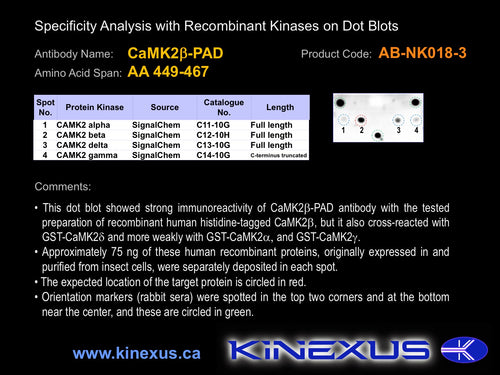Product Name:
CaMK2d-NT
Product Number:
ab-nk018-3
Target Full Name: Calcium/calmodulin-dependent protein-serine kinase 2 delta
Target Alias: Calcium/calmodulin-dependent protein kinase II delta; Calcium/calmodulin-dependent protein kinase type II delta chain; CaM kinase II delta; CaMK2-delta; CaMKD; CaMK-II delta; CaM-kinase II delta; KCC2D; KCCD; MGC44911; CCDS3703.1; ENSG00000145349
Product Type Specific: Protein kinase pan-specific antibody
Antibody Code: NK019-3
Antibody Target Type: Pan-specific
Protein UniProt: Q13557
Protein SigNET: Q13557
Antibody Type: Polyclonal
Antibody Host Species: Rabbit
Antibody Immunogen Source: Human CaMK2d sequence peptide Cat. No.: PE-01BCI85
Antibody Immunogen Sequence: CTRFTDEYQLFEELGKGAFS
Antibody Immunogen Description: Corresponds to amino acid residues C7 to S26; N-terminus and kinase domain I, highly conserved in all CaMK2 isoforms
Production Method: Corresponds to amino acid residues C7 to S26; N-terminus and kinase domain I, highly conserved in all CaMK2 isoforms
Antibody Modification: Protein kinase pan-specific antibody
Antibody Concentration: 0.75 mg/ml
Storage Buffer: Phosphate buffered saline pH 7.4, 0.05% Thimerasol
Storage Conditions: For long term storage, keep frozen at -40°C or lower. Stock solution can be kept at +4°C for more than 3 months. Avoid repeated freeze-thaw cycles.
Product Use: Western blotting | Antibody microarray
Antibody Dilution Recommended: 2 µg/ml for immunoblotting
Antibody Species Reactivity: Human
Antibody Positive Control: The observed molecular mass of the processed target protein on SDS-PAGE gels is reported to be around 50-55 kDa.
Related Product 1: CaMK2d-NT blocking peptide
Related Product 2: CaMKII pT286/pT287 phosphosite-specific antibody (Cat. No.: AB-NK302-2)
Related Product 3: Autocamtide-2 peptide - Autocamtide 2 CaMK2-derived peptide substrate
Related Product 4: CAMK2Subtide - CaMK2a protein kinase substrate peptide
Related Product 5: Syntide-2 KinSub - Syntide-2 protein kinase substrate peptide
Scientific Background: CaMK2d is a protein-serine/threonine kinase of the CaMK group and CaMK2 family. It is a calcium/calmodulin-activated protein kinase. It is activated in response to a rise in intracellular Ca(2+) concentration. Autophosphorylation at Thr-287 probably increases phosphotransferase activity in a Ca(2+)-independent manner.


